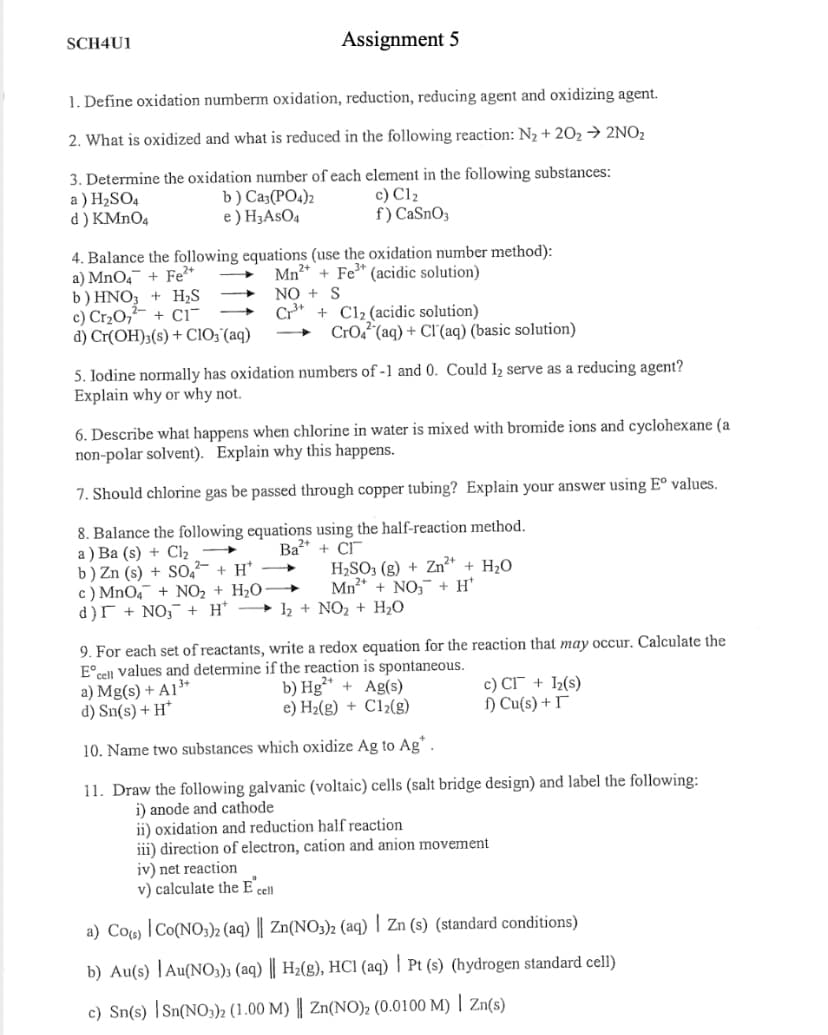1. Define oxidation numberm oxidation, reduction, reducing agent and oxidizing agent. 2. What is oxidized and what is reduced in the following reaction: N2 + 202 → 2NO2
1. Define oxidation numberm oxidation, reduction, reducing agent and oxidizing agent. 2. What is oxidized and what is reduced in the following reaction: N2 + 202 → 2NO2
Chapter4: Types Of Chemical Reactions And Solution Stoichiometry
Section: Chapter Questions
Problem 10RQ
Related questions
Question

Transcribed Image Text:SCH4U1
Assignment 5
1. Define oxidation numberm oxidation, reduction, reducing agent and oxidizing agent.
2. What is oxidized and what is reduced in the following reaction: N2 + 202→ 2NO2
3. Determine the oxidation number of each element in the following substances:
a ) H2SO4
d ) KMNO4
b) Ca3(PO4)2
e ) H3ASO4
с) Clz
f) CaSnO3
4. Balance the following equations (use the oxidation number method):
a) MnO4¯ + Fe
b) HNO3 + H;S
c) Cr2O,²- + ci~
d) Cr(OH)3(s) + ClO;'(aq)
Mn?* + Fe* (acidic solution)
NO + S
+ Cl2 (acidic solution)
CrO2 (aq) + Cl'(aq) (basic solution)
5. Iodine normally has oxidation numbers of -1 and 0. Could I2 serve as a reducing agent?
Explain why or why not.
6. Describe what happens when chlorine in water is mixed with bromide ions and cyclohexane (a
non-polar solvent). Explain why this happens.
7. Should chlorine gas be passed through copper tubing? Explain your answer using Eº values.
8. Balance the following equations using the half-reaction method.
а) Ва (s) + CI,
b) Zn (s) + S0,- + H*
c) MnO4 + NO, + H2O
d)r + NO,¯ + H'
Ba* + CI
H,SO3 (g) + Zn²* + H,O
Mn* + NO, + H*
h + NO2 + H2O
9. For each set of reactants, write a redox equation for the reaction that may occur. Calculate the
E°cell values and determine if the reaction is spontaneous.
a) Mg(s) + A1³*
d) Sn(s) + H*
b) Hg** + Ag(s)
e) H2(g) + C12(g)
c) CI + ½(s)
) Cu(s) + I
10. Name two substances which oxidize Ag to Ag*.
11. Draw the following galvanic (voltaic) cells (salt bridge design) and label the following:
i) anode and cathode
ii) oxidation and reduction half reaction
iii) direction of electron, cation and anion movement
iv) net reaction
v) calculate the E cll
a) Co«) |Co(NO3)2 (aq) || Zn(NO3)2 (aq) | Zn (s) (standard conditions)
b) Au(s) |Au(NO;); (aq) || H2(g), HCI (aq) | Pt (s) (hydrogen standard cell)
c) Sn(s) |Sn{NO3))2 (1.00 M) || Zn(NO)2 (0.0100 M) | Zn(s)
Expert Solution
This question has been solved!
Explore an expertly crafted, step-by-step solution for a thorough understanding of key concepts.
Step by step
Solved in 2 steps with 1 images

Knowledge Booster
Learn more about
Need a deep-dive on the concept behind this application? Look no further. Learn more about this topic, chemistry and related others by exploring similar questions and additional content below.Recommended textbooks for you


Chemistry for Engineering Students
Chemistry
ISBN:
9781337398909
Author:
Lawrence S. Brown, Tom Holme
Publisher:
Cengage Learning

Chemistry by OpenStax (2015-05-04)
Chemistry
ISBN:
9781938168390
Author:
Klaus Theopold, Richard H Langley, Paul Flowers, William R. Robinson, Mark Blaser
Publisher:
OpenStax


Chemistry for Engineering Students
Chemistry
ISBN:
9781337398909
Author:
Lawrence S. Brown, Tom Holme
Publisher:
Cengage Learning

Chemistry by OpenStax (2015-05-04)
Chemistry
ISBN:
9781938168390
Author:
Klaus Theopold, Richard H Langley, Paul Flowers, William R. Robinson, Mark Blaser
Publisher:
OpenStax

Chemistry & Chemical Reactivity
Chemistry
ISBN:
9781133949640
Author:
John C. Kotz, Paul M. Treichel, John Townsend, David Treichel
Publisher:
Cengage Learning

Chemistry & Chemical Reactivity
Chemistry
ISBN:
9781337399074
Author:
John C. Kotz, Paul M. Treichel, John Townsend, David Treichel
Publisher:
Cengage Learning

World of Chemistry, 3rd edition
Chemistry
ISBN:
9781133109655
Author:
Steven S. Zumdahl, Susan L. Zumdahl, Donald J. DeCoste
Publisher:
Brooks / Cole / Cengage Learning